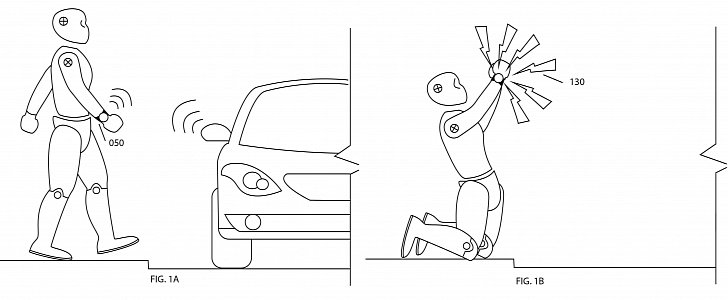The autonomous cars are coming, and with them, we'll witness a pretty dramatic change in the way traffic - especially around town - will work. The rules will have to adapt, the infrastructure is going to suffer some modifications and, above all else, the way people relate to vehicles will never be the same again. We'll basically have robots roaming among us, and it that doesn't scare you, then it's really nice to meet you, John Connor.
But regardless of how much change the advent of self-driving vehicles will bring, one thing will remain the same: the pedestrians are still going to be the most vulnerable element of traffic. The driverless cars are being advertised as the solution to curb the numbers of accidents, but you don't have to be a psychic to see they won't be eradicated completely.
We've shown you a few weeks back an older patent created by Google that saw the hood of the car turned into a giant pedestrian sticky trap. The hapless victim would be glued to the front of the car, keeping them from ricocheting into other vehicles, the scenery or simply falling onto the hard asphalt. Naturally, to say it was "just an idea" would be a euphemism, which would also explain why we're only just now finding out about this, two years later.
Completely aware of the stupidity behind this plan - and fed up with the obvious bias towards the vehicles in the way our cities are designed - City Observatory columnist Joe Cortright imagines three more patents that would make this pedestrian/driverless car interaction even safer.
The first one involves shock bracelets for everyone walking on the streets. Fearing the mental pedestrians will take advantage of the AI's programming that prevents it from injuring a human being, jaywalking will simply become the norm.
To prevent that from happening, all pedestrians would have to add one more device to their arsenal of wearable gadgets: a shock bracelet. Whenever a car detects a possible collision with a pedestrian, his bracelet would go off, warning him to stay on the sidewalk.
The second proposed solution is the personal airbag. This doesn't need any explaining as it's pretty obvious how it would work. Or not work, depending on who's making the inflator. Finally, the third one lifts any possible remaining shroud of doubt regarding the author's seriousness, as he proposes a rocket belt that would simply boost the pedestrian out of the car's way (and on to a very painful landing, we suppose).
"We offer these ideas partly in jest, but mostly to underscore the deep biases we have in thinking about how to adapt our world for new technology," the author concludes, before going on to show how walking has become "a second-class form of transportation." Autonomous cars won't do anything to change that - at least not for the better from a pedestrian's point of view - but they do promise more safety and easier access to motorized transport. Assuming, of course, that's what the people actually want.
We've shown you a few weeks back an older patent created by Google that saw the hood of the car turned into a giant pedestrian sticky trap. The hapless victim would be glued to the front of the car, keeping them from ricocheting into other vehicles, the scenery or simply falling onto the hard asphalt. Naturally, to say it was "just an idea" would be a euphemism, which would also explain why we're only just now finding out about this, two years later.
Completely aware of the stupidity behind this plan - and fed up with the obvious bias towards the vehicles in the way our cities are designed - City Observatory columnist Joe Cortright imagines three more patents that would make this pedestrian/driverless car interaction even safer.
The first one involves shock bracelets for everyone walking on the streets. Fearing the mental pedestrians will take advantage of the AI's programming that prevents it from injuring a human being, jaywalking will simply become the norm.
To prevent that from happening, all pedestrians would have to add one more device to their arsenal of wearable gadgets: a shock bracelet. Whenever a car detects a possible collision with a pedestrian, his bracelet would go off, warning him to stay on the sidewalk.
The second proposed solution is the personal airbag. This doesn't need any explaining as it's pretty obvious how it would work. Or not work, depending on who's making the inflator. Finally, the third one lifts any possible remaining shroud of doubt regarding the author's seriousness, as he proposes a rocket belt that would simply boost the pedestrian out of the car's way (and on to a very painful landing, we suppose).
"We offer these ideas partly in jest, but mostly to underscore the deep biases we have in thinking about how to adapt our world for new technology," the author concludes, before going on to show how walking has become "a second-class form of transportation." Autonomous cars won't do anything to change that - at least not for the better from a pedestrian's point of view - but they do promise more safety and easier access to motorized transport. Assuming, of course, that's what the people actually want.

